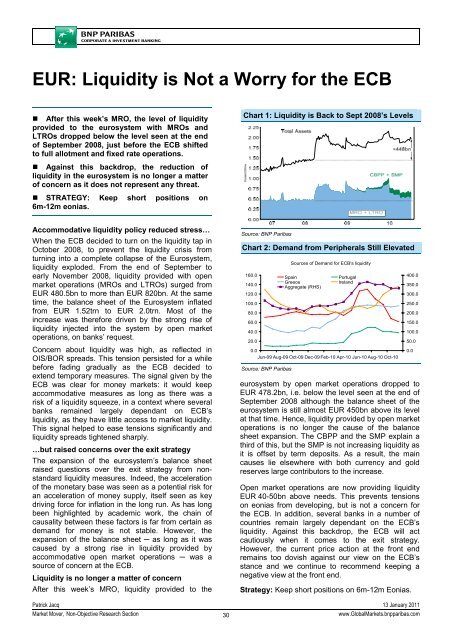Market Economics | Interest Rate Strategy - BNP PARIBAS ...
Market Economics | Interest Rate Strategy - BNP PARIBAS ...
Market Economics | Interest Rate Strategy - BNP PARIBAS ...
You also want an ePaper? Increase the reach of your titles
YUMPU automatically turns print PDFs into web optimized ePapers that Google loves.
EUR: Liquidity is Not a Worry for the ECB<br />
• After this week’s MRO, the level of liquidity<br />
provided to the eurosystem with MROs and<br />
LTROs dropped below the level seen at the end<br />
of September 2008, just before the ECB shifted<br />
to full allotment and fixed rate operations.<br />
• Against this backdrop, the reduction of<br />
liquidity in the eurosystem is no longer a matter<br />
of concern as it does not represent any threat.<br />
• STRATEGY: Keep short positions on<br />
6m-12m eonias.<br />
Chart 1: Liquidity is Back to Sept 2008’s Levels<br />
Accommodative liquidity policy reduced stress…<br />
When the ECB decided to turn on the liquidity tap in<br />
October 2008, to prevent the liquidity crisis from<br />
turning into a complete collapse of the Eurosystem,<br />
liquidity exploded. From the end of September to<br />
early November 2008, liquidity provided with open<br />
market operations (MROs and LTROs) surged from<br />
EUR 480.5bn to more than EUR 820bn. At the same<br />
time, the balance sheet of the Eurosystem inflated<br />
from EUR 1.52trn to EUR 2.0trn. Most of the<br />
increase was therefore driven by the strong rise of<br />
liquidity injected into the system by open market<br />
operations, on banks’ request.<br />
Concern about liquidity was high, as reflected in<br />
OIS/BOR spreads. This tension persisted for a while<br />
before fading gradually as the ECB decided to<br />
extend temporary measures. The signal given by the<br />
ECB was clear for money markets: it would keep<br />
accommodative measures as long as there was a<br />
risk of a liquidity squeeze, in a context where several<br />
banks remained largely dependant on ECB’s<br />
liquidity, as they have little access to market liquidity.<br />
This signal helped to ease tensions significantly and<br />
liquidity spreads tightened sharply.<br />
…but raised concerns over the exit strategy<br />
The expansion of the eurosystem’s balance sheet<br />
raised questions over the exit strategy from nonstandard<br />
liquidity measures. Indeed, the acceleration<br />
of the monetary base was seen as a potential risk for<br />
an acceleration of money supply, itself seen as key<br />
driving force for inflation in the long run. As has long<br />
been highlighted by academic work, the chain of<br />
causality between these factors is far from certain as<br />
demand for money is not stable. However, the<br />
expansion of the balance sheet ─ as long as it was<br />
caused by a strong rise in liquidity provided by<br />
accommodative open market operations ─ was a<br />
source of concern at the ECB.<br />
Liquidity is no longer a matter of concern<br />
After this week’s MRO, liquidity provided to the<br />
Source: <strong>BNP</strong> Paribas<br />
Chart 2: Demand from Peripherals Still Elevated<br />
Sources of Demand for ECB's liquidity<br />
160.0<br />
Spain<br />
Portugal<br />
Greece<br />
Ireland<br />
140.0<br />
Aggregate (RHS)<br />
120.0<br />
100.0<br />
80.0<br />
60.0<br />
40.0<br />
20.0<br />
0.0<br />
Jun-09 Aug-09 Oct-09 Dec-09 Feb-10 Apr-10 Jun-10 Aug-10 Oct-10<br />
Source: <strong>BNP</strong> Paribas<br />
eurosystem by open market operations dropped to<br />
EUR 478.2bn, i.e. below the level seen at the end of<br />
September 2008 although the balance sheet of the<br />
eurosystem is still almost EUR 450bn above its level<br />
at that time. Hence, liquidity provided by open market<br />
operations is no longer the cause of the balance<br />
sheet expansion. The CBPP and the SMP explain a<br />
third of this, but the SMP is not increasing liquidity as<br />
it is offset by term deposits. As a result, the main<br />
causes lie elsewhere with both currency and gold<br />
reserves large contributors to the increase.<br />
Open market operations are now providing liquidity<br />
EUR 40-50bn above needs. This prevents tensions<br />
on eonias from developing, but is not a concern for<br />
the ECB. In addition, several banks in a number of<br />
countries remain largely dependant on the ECB’s<br />
liquidity. Against this backdrop, the ECB will act<br />
cautiously when it comes to the exit strategy.<br />
However, the current price action at the front end<br />
remains too dovish against our view on the ECB’s<br />
stance and we continue to recommend keeping a<br />
negative view at the front end.<br />
<strong>Strategy</strong>: Keep short positions on 6m-12m Eonias.<br />
400.0<br />
350.0<br />
300.0<br />
250.0<br />
200.0<br />
150.0<br />
100.0<br />
50.0<br />
0.0<br />
Patrick Jacq 13 January 2011<br />
<strong>Market</strong> Mover, Non-Objective Research Section<br />
30<br />
www.Global<strong>Market</strong>s.bnpparibas.com

















